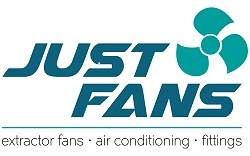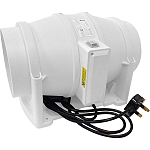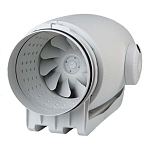Information & frequently asked questions
Fans
Fans used for ventilation and air movement work by one of two different methods. The most common is the axial or propeller fan, similar to those used on stands for moving air in a room or used in computers for cooling power supplies. They can move large volumes of air at very low pressures.
The other type is a centrifugal unit, and these are similar to a centrifugal water pump. They have a plate with radial vanes and the air is forced out by the centrifugal force. These are either an in- line fan, where the air goes straight through parallel to the fan shaft, or the other type is the "squirrel cage" fan where air is drawn into the centre of the fan and exhausted through the side casing, perpendicular to the impeller axis. The latter is rarely used in domestic fans.
Axial fans are the most common, as they are the cheapest to produce and more compact. One disadvantage they have is that they cannot develop high pressures, with a limit around 60Pa-80pa for household sizes.
Centrifugal fans with the same size inlets as axial fans can develop pressures up to 4 times that of an equivalent axial fan, however, they also usually cost a minimum of twice that of an equivalent axial fan. Fans can either be surface mounted or in-duct, where it is in the middle of a duct run.
Fan Curves On a few fans, we show a graph of airflow vs static pressure (back pressure, sort of). This means that if you have a certain pressure that the fan is pushing or pulling against, then you know the likely airflow rate.
Please click HERE for more details on fan curves.
Ducting The usual materials for ducting are either a steel spiral sheetmetal rigid pipe or a flexible PVC or aluminium foil tube supported by spiral steel wire. The latter is easiest to install and is cheap, however it is very restrictive to airflow. The steel pipe requires special tools to be installed properly, which most homeowners or plumbers do not have. The most common fault is to chose ducting which is undersized for the fan capacity, and this increases the noise of the system through the higher air velocity and also increases the friction in the system, which makes the fans work harder or require them to be larger than necessary.
Duct sizes should generally be kept as large as possible A small difference in diameter makes a huge difference to the amount of restriction, as the back pressure from friction losses is inversely proportional to the power of 4.
Duct sizing
Let us take the example of an inline fan in the ceiling: If we assume that the peak pressure of the axial fans in a heat and light fan units is around 60Pa and a peak flow rate of 70l/s in free air with a more or less straight to circular curve between the points (see below). (or maybe from the manufacturers data) We also make some other assumptions: The exhaust grille (and intake if it has one) is 10-20Pa pressure loss.
The correctly sized ducting will be 1.5-3.5pa per metre
Each bend of flexiduct is equivalent to 1.5 -2 metres extra duct length
We have 2 bends, an exhaust grille, and an intake grille, as it is part of the fan and hence part of its quoted performance.
The duct length is 3m.
Our pressure loss is 15pa for each grille + ((3m+2*1.5m per bend)*2 Pa per metre) = 30+ 12 =42Pa.
We know look up our fan curve for 42Pa static pressure and read off the amount of air being moved from the bottom axis.
At the very minimum, the duct size should be at least a large as the size of the fan, i.e. a 150mm fan uses 150mm ducting.
Noise Ratings
Most Sound levels are rated in decibels, measured at 3 meters. (Although some manufacturers on their data sheets state dB@ 1.5 meters. In these cases we have converted to @3m by subtracting 6dB.) Be aware that some fans give noise ratings in SOUND POWER LEVELS, also in decibels, which is a different measure and is normally about 21 decibels higher than the Sound Pressure @3m measurement.
An important thing to remember is that they are logarithmic, which means that they do not go up in a linear (straight-line) fashion, rather it is exponential. This means that a (more or less) 10db increase is twice as loud. A 2-3 dB difference is considered to be a just noticeable to most people, although this varies.
The search for the silent/quiet extractor fan.
Many people want to upgrade their current extractor fan with a quiet version, as most cheap bathroom fans are quite noisy. There are a number of options available.
Firstly, it depends on the duct length. If its only a matter of 3-5 meters, the TD range of mixvent fans will suffice. These are a half way house between an axial fan( suitable for short duct lengths) and a centrifugal fan (suitable for long ducting lengths) and and very quiet. Examine the dB readings on the datasheet for comparison with others.
If a more powerful extraction is required, a centrifugal fan is a must. In this case, our range of Acoustic fans are as quiet as you can get. They have sound insulation inside the box to absorb noise. They are also very powerful and easily cleaned and suitable for domestic/industrial applications where sound levels are a problem.
To absorb any noise from the rushing of air, rather than the fan chassis breakout noise itself, use acoustic ducting and/or a silencer at the input/ output. These are just hollow tubes, acoustically designed to absorb the white noise you get at the end of ducting.
Using one of these solutions will normally solve any noise problem.
Generally, the noise is also proportional to the amount of airflow and the fan speed, If you have problems with a noisy fan or are putting a system in:
1/ Mount the fan towards the end of the duct
2/ Use larger ducting to reduce the air velocity, and hence the noise through fittings and grilles
3/ Use a larger fan but turn it slower. This can make a big difference, as the noise varies with the square of the fan tip speed.
4/ Try using "acoustic ducting".
| Bathrooms | 10 - 15 |
| Bakery | 20 - 30 |
| Canteen | 8 - 12 |
| Commercial kitchen | 30+ |
| Domestic Kitchen (with hood advised) | 8-13 |
| Workshop | 8 - 10 |
| Fume cupboard | 40 - 50 |
| Garage | 6 - 8 |
| Spray booth | 20 - 50 |
| Warehouse | 3 - 6 |
| Workshops | 6 - 10 |
| Wet Room/Shower | 15-20 |
Fan sitting in Bathrooms.
Building regs (BS7671 the Requirements for Electrical Installations) state, in section 601 that any devices in Zone 1 of a bathroom must be running on a low voltage, normally 12volts.
This normally means putting the transformer seperate in Zone 3.
ALTHOUGH other building regulations also say anything IPX4 and above (where the second digit of the IP rating is 4 or more) can be used if protected with a 30mA RCD.
Zone 1 is defined as the area around the bathtub or shower basin up to a height of 2.25m above the floor and at a radius of 1.2m from the water outlet.
Cooling Server Rooms. (Using fans not air-conditioners)
We have had many customers inquiring about how to cool a server room using fans. The answer is obvious, LARGE airflow and when calculated correctly, an extract and input fan system can cool a server room for much less money per year than using air conditioning units AND move some useful warm air to other areas needing heating or even better, a heat recovery unit. This saves money and CO2 emissions yet again and contributes to a greener future by using as energy efficient a system, as possible.
Ask for details.
For the technically minded, a very useful residential duct systems design paper. Download HERE.
Building regs compliance guide (2010) HERE
Click HERE to download the Governments Ventilation Building Regs. (Part F)
Excellent guide to kitchen extraction and odour control HERE
Read our WEEE ((Waste Electrical and Electronic Equipment) regulations) policy HERE.
Atex Rated Fans. (Using fans for explosive enviroments.)
Although we offer various Atex rated fans online, we do not specify, so the end user must know what Atex rating they need and whether it is suitable for their application. We take no liability for the use of any Atex fan. There are professional Atex specifiers which will be happy to help and can specify for your needs (and charge accordingly!) but we do not as we are not qualified to do so and will not due to the risk of litigation. It is VERY important to have the correct rating as the risk of explosion when extracting certain solvents can be very high.
If we are given information on the application and the sovents used we can often offer suggestions as to the correct gas group and ignition temperature (and therefore Atex rating) of the fan you need, but the user would have to go away and verify this is correct for their application by research and/or asking a professional Atex specifier. See below for more Atex information.
Guide to Atex Classification
Hazardous area guide
Gas list from IEC-60079-20-1
Use of TP and TK connections on commercial fans.
The thermal protection in motors is an important protective device. They are basically a switch that goes open circuit in the event of an overheat. The device is manufactured into motors due to the possibility of excessive heat caused by things like the following:
1) Overloading
2) High Ambient Temperature
3) Variations in power supply
If an installer fails to connect the thermal protectors they can allow the motors internal temperature to significantly increase beyond the maximum rating of the motor.
If they are used, the motors would be protected and they wouldn’t overheat. The thermal protection serves as an indicator of possible danger to the motor.
Most manufacturers include in the installation instructions that it is advisable to use them, especially if used in kitchens or high temperature enviroments.
If a fan fails under warranty and the TK connections have NOT been used they will often refuse to honour any warranty, as it is an industry standard that thermal protection is connected within all motors. Without thermal protection you are unable to monitor and protect the motor.
The TP connections can be either connected to a suitable speed controller or DOL starter. In some cases the live feed can be fed through the TP connections to switch off the power in the event of an overheat but this means it is not externally resettable(a requirement for all inline cased axials) and will re-start on its own when it has cooled down.
1 x Etaline 710mm - D4 02 3 Phase1 x HRSB/6-710/24-BZ1 x Helios HQW-630/4 - IP552 x Elta SCP630/4-1AC - IP551 x CBMT/Q 150-27 1 HEATER KIT2 x Duct Mounted Filter Box - G4 Grade Panel - 355mm1 x Soler & Palau TCBT/2-315/H-B E70 - IP552 x KABT High Temp Acoustic Kitchen Fan & Inverter Kit - KABT/4-12000/560 ND - Pack 51 x S & P Aluminium Axial Fan Louvre Shutter - PER-CR- 5001 x Duct Mounted Filter Box - 500mm - M6 grade Bag filter1 x CBMT/Q 400-55 1 HEATER KIT1 x Helios GigaBox 500mm GBW 500/4 centrifugal1 x Soler & Palau - HXBR/4-400/H - IP541 x Direct Saturday Delivery Surcharge1 x SS Series Slimseal 800mmx800mm Damper1 x SD-MUB Vibration pad set1 x OZEO ECOWATT 2 Wired Low Energy Whole House Extract Ventilation Unit1 x Axial Roof mounted Extract/Supply Fan- -HCTT/4-1000-A 5.5kw1 x S & P Aluminium Axial Fan Louvre Shutter - PER-CR- 3551 x CTI CVA-N 500/560 Outdoor cover for CVAB/T Fans1 x GB-WSD 250 Weather Protection hood for the Giga-Box Fans - 250mm1 x Soler & Palau - HCBT/6-450/H - IP651 x Elta SCP450-1EC - IP551 x HQD 355/4 Plate Axial Fan (4-pole)1 x Soler & Palau - HCBB/2-355/H - IP651 x Helios HQW-450/4 - IP551 x Soler & Palau - HCBB/6-355/H - IP651 x Jetflow-HIT Metal inline - 160mm1 x HRB/3-200-BMPN1 x Soler & Palau - HXBR-200 ECOWATT - IP441 x 110 x 54mm Flat Channel Connector1 x 110 x 54mm Vertical 90 Degree Bend1 x 110 x 54mm Equal Horizontal T-Piece1 x Helios HQW-200/4 - IP551 x 110 x 54mm Elbow Bend Male1 x Soler & Palau TCBB/4-450/H - IP651 x Elta SPA400/46-3AC - IP541 x Soler & Palau - HCBT/6-400/H - IP651 x Hydor HPA400/6-1A1 x Compact SCD450/4-1AC1 x Helios HQW-560/6 - IP551 x Elta Qube SQU Centrifugal Box Fan - SQU4/4-3 HTS - Three Phase1 x Elta Cased Axial Flange - 1000mm1 x 204x60mm Flat Channel Clip (Pack of 5)1 x CCpro 40 (1CC9402) Long Casing Extension1 x Elta SCP560/4-1AC - IP551 x Quietflow SQS200-1ECL - Centrifugal Box Fan1 x 200mm - 150mm Stainless Steel Ducting Reducer1 x Access Door for Circular Duct - 400 x 300 - SIZE 501 x 150mm - 100mm Stainless Steel Ducting Reducer1 x 204x60mm Flat Channel Connector1 x Blast Gate (Manual) 100mm1 x Blast Gate (Manual) 180mm2 x Elta SCP560/4-3AC - IP551 x Etamaster EM 200 EC 01 inline mix-vent fan1 x Soler & Palau TCBT/4-710/H - IP651 x CBM Low Pressure Centrifugal Fan - CBM 9/9 6 Pole 200watt VR RE1 x Gorilla HVLSX501 x Centrifugal Roof Mounted Fans MAX-TEMP CTVB / CTVT Series - Vertical Discharge1 x Bellimo TF24S Actuator 24V1 x Etaline 315mm - D2 01 3 Phase1 x Purlin Box 500/560 for RAW Cowls1 x DT-1 Duct Mounted Thermostat1 x EC Trickle and boost module - IP561 x HCFT/4-5001 x MPC 450 E4 20 - High Temp Acoustic Box Fan1 x Soler & Palau - HCBT/6-710/H - IP651 x Helios GigaBox 355mm GBD 355/4/4 centrifugal1 x IK - Inspection Door & Drain Plug for TLZ 450 R1 x Curved Blade Grille 600x600 (2way blow)1 x Rotorex HXBR 250mm Plate Axial Fan - Single Phase (2-pole)1 x CBM 15/15 6p 3phase 2.2kw1 x Helios HQW-250/4 - IP551 x CBM 15/11 6P C IP55 - Closed Motor - Single Phase1 x Anti Vibration Mounts - Small - Pack of 4 - AVM21 x Activated Carbon Discarb Cell - 598H x 598W x 598Dmm1 x CBM 12/9 CM/AL 1100W 6PT - Closed Motor1 x Elta SLC400-1EC -IE5 Motor- IP551 x KD 250 M1 Circular duct fan1 x AL 400 EC 01 AXIALINE - High Performance Long Cased Axial Fan1 x EM 400 E4M 01 - Mixed Flow Duct Fan - 400mm1 x LCA403218 - Long Cased Axial Fan1 x Helios TSD 5.5 Transformer Speed Control (400v)1 x Elta Variable Speed Drive IP66 - 4.0KW1 x CRBB/4-400/J ML UL1 x Elta SLC560/4C-3AC - IP551 x 56Jm/16/4/5/32/1Ph Long cased axial1 x Elta SLC560/4B-1AC - IP551 x Belt Drive Cased Axial Fan - 560mm - L version1 x HXP560/4-3 - 4 Pole - Three Phase1 x HRB/6-630-30-APN1 x Elta SPA630/68-3AC - IP541 x FlameProof Plate Axial Fan - Single Phase - 7.5 inches - Eexd IIC T4 -4pole1 x Elta EC Electronic Controller1 x FlameProof Plate Axial Fan - Single Phase - 12 inches - Eexd IIC T4 -4pole1 x HRB/6-630-25-BPN1 x Three Phase ATEX Compact axial fan - 355mm - compactA3ATE1 x Easy-fix termination kit - High Rise Ventilator - EFT1 x Systemair AR 200E2 Sileo - IP441 x Hydor HPA250/2-11 x Elta Wall Cowl SWC56/631 x GRA-100 External Grill by S&P
Best sellers


